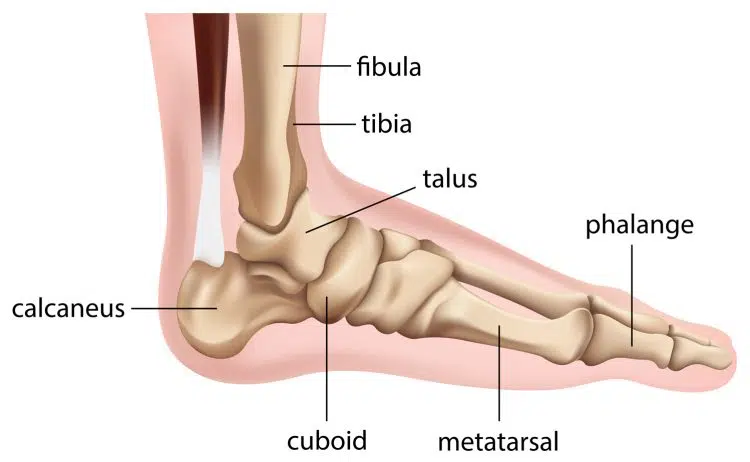A chain is only as strong as its weakest link, and for humans, that weak link is often the ankle joint. That’s hardly surprising given the complexity and relative size of the average ankle and how much stress it has to contend with.
Every step you take loads your ankles with at least your body weight. Forces drastically exceed body weight when you run, jump, do loaded squats, or carry weight. Uneven surfaces challenge your ankles even more, and it doesn’t take much to lose your footing.
With that in mind, it’s hardly surprising that ankle sprains are one of the most common musculoskeletal injuries (1). As someone who has suffered several ankle sprains, I can tell you firsthand how painful and debilitating this injury can be.
In fact, some doctors I know tell me that there is very little difference between the pain of an ankle sprain and a full-on fracture. Recovery time is also similar, especially for severe sprains. BTW, an ankle sprain causes damage to ligaments, while strains damage muscle. In contrast, a fracture affects bones but also disrupts ligaments and muscles.
The good news is there are steps you can take to make your joints more resilient and less prone to sprains and other ankle injuries. While I cannot guarantee you’ll make your ankles 100% bulletproof, I can help you lower your risk of injury.
In this article, I reveal the exercises that I, as a veteran personal trainer and sports therapist, use to strengthen my clients’ ankles.
Level Up Your Fitness: Join our 💪 strong community in Fitness Volt Newsletter. Get daily inspiration, expert-backed workouts, nutrition tips, the latest in strength sports, and the support you need to reach your goals. Subscribe for free!
Ankle Anatomy Basics
Take a look at your wrist. Yes, I know this article is about ankles, but these two joints share several structural and functional similarities.
Note how you can move your wrist in multiple directions – it’s a very dexterous joint. However, it’s also very strong and can support massive loads, such as during activities like handstands, dips, and bench presses.
Now consider the ankle.
It’s arguably more complex and mobile than the wrist, has to support even more weight, and does most of its work out of sight, relying on proprioception (innate sense) to determine its position. Plus, it has to react much faster to stimuli, such as when you walk or run on uneven ground.
Given its structural complexity, functions, and the challenges faced by the underappreciated ankle joint, it’s surprising that injury is not a more common occurrence! And speaking of complexity, let’s take a moment to marvel at the structures that make up your ankle joints (2).
Ankle Bones
- Tibia
- Fibula
- Talus
- Calcaneus
Ankle Ligaments
- Tibionavicular ligament
- Tibiocalcaneal ligament
- Posterior tibiotalar ligament
- Anterior tibiotalar ligament
- Anterior talofibular ligament
- Calcaneofibular ligament
- Posterior talofibular ligament
- Anterior inferior tibiofibular ligament
- Posterior inferior tibiofibular ligament
- Interosseous ligament
- Transverse ligament
Ankle Muscles
- Tibialis anterior
- Peroneus longus
- Peroneus brevis
- Gastrocnemius
- Soleus
- Flexor hallucis longus
- Flexor digitorum longus
- Tibialis posterior
- Extensor digitorum longus
- Extensor hallucis longus
Ankle Nerves
- Saphenous nerve
- Superficial peroneal nerve
- Deep peroneal nerve
- Tibial nerve
- Sural nerve
- Medial plantar nerve
- Lateral plantar nerve
- Calcaneal nerve
- Medial dorsal cutaneous nerve
- Intermediate dorsal cutaneous nerve
Ankle Joint Movements
- Plantarflexion
- Dorsiflexion
- Inversion
- Eversion
The good news is that you don’t have to know the names of any of these structures to build strong, stable ankles. However, seeing them listed in black and white illustrates how complex the ankle joint is and why sprained ankles and other injuries are so common.
The Best Exercises for Ankle Stability, Balance, and Strength
While seated and standing calf raises are good for building basic ankle strength, there are several additional movements you can use to further bulletproof your ankles. So, build stronger, more stable, more injury-resistant ankles with these essential exercises.
1. Single-Leg Balance
If there is one must-do exercise on this list, it’s the single-leg balance. Simply standing on one leg develops balance and proprioception while strengthening your deep ankle stabilizers. You may also feel it in your glutes and outer thighs, as you’ll need to use these muscles to keep your pelvis level.
Best of all, you can do the basic version of this exercise almost anywhere and anytime, e.g., waiting in line at the bank or post office, brushing your teeth, or talking on the phone.
Steps:
- Stand in good posture, with your core braced and shoulders down and back.
- Shift your weight over onto one foot. Bend your supporting knee slightly.
- Lift your other foot a few inches off the floor.
- Hold for the prescribed duration, e.g., 45-60 seconds.
- Switch legs and repeat.
Progressions/variations:
- Close your eyes.
- Stand on an unstable surface, e.g., a pillow, foam pad, or folded gym mat.
- Lightly throw and catch a ball.
- Move your arms around.
2. Standing Tibialis Raise
While most exercisers train their calves, far fewer pay attention to the opposite muscle, the tibialis anterior (TA). That’s like training your triceps but not your biceps! This simple exercise is one of the simplest ways to work the TA, ensuring the muscles at the front of your ankle are as strong as those on the back.
Level Up Your Fitness: Join our 💪 strong community in Fitness Volt Newsletter. Get daily inspiration, expert-backed workouts, nutrition tips, the latest in strength sports, and the support you need to reach your goals. Subscribe for free!
Steps:
- Lean your back against a wall and place your feet out in front of you.
- Contract your quadriceps.
- Using the muscles on the front of your shins, pull your toes up toward your knees.
- Hold for 2-3 seconds, relax, and repeat.
Progressions/variations:
- Place your heels on weight plates to increase the range of motion.
- Put ankle weights around your feet for more resistance.
- Lift both feet together or use an alternating foot action as preferred.
- You can also do this exercise seated.
3. Single Leg Banded Tibialis Raise
Exercise #2 uses gravity and muscle tension to overload your tibialis anterior muscle. While that’s a good place to start, as your TA gets stronger, you’ll need to make it work harder if you want to strengthen it further. Resistance band tibialis raises are one of the most convenient ways to develop this critical ankle stabilizer.
Steps:
- Attach a loop-type resistance band to a low anchor.
- Sit on the floor with one leg straight.
- Place your extended foot in the loop.
- Shuffle backward to tension the band.
- Keeping your leg straight, pull your toe up toward your shin against the tension offered by the band.
- Point your toe as far as you can without the band slipping off your foot.
- Repeat for the prescribed number of reps and then switch legs.
Progressions/variations:
- Move back to make this exercise more demanding or more forward to make it easier.
- Pause with your toes pulled up to maximize muscle engagement.
- Wrap the band around your foot and not just over it to prevent it from slipping.
4. Resistance Banded Ankle Eversion
Ankle eversion involves turning your foot so the sole faces outwards. This exercise targets the muscles on the outside of your ankle, which are collectively known as the evertors. The evertors and associated ligaments are often damaged when you roll an ankle. This common post-sprain rehab exercise will help strengthen and stabilize your ankle joint.
Steps:
- Attach a loop-type resistance band to a low anchor.
- Sit side-on on the floor with your furthest leg extended. Loop the band over your forefoot.
- Roll your ankle inward and then extend it outward against the resistance offered by the band.
- Continue for the desired number of reps and then switch sides.
Progressions/variations:
- Move away from the anchor point to make this exercise harder or toward it to make it easier.
- Wrap the band around your foot and not just over it to prevent it from slipping.
- Start with a very light band and reduced range of motion if you are recovering from an ankle injury.
5. Resistance Banded Ankle Inversion
This resistance band exercise targets the muscles on the inside of your ankle, collectively known as the invertors. Strengthening these muscles will help stabilize your ankles and help prevent ankle sprains. This is a critical exercise for anyone who walks or runs on uneven surfaces or plays sports that involve lateral movements, e.g., basketball, soccer, etc.
Steps:
- Attach a loop-type resistance band to a low anchor.
- Sit side-on to the anchor with your nearest leg extended. Loop the band over your forefoot.
- Roll your ankle outward and then push it inward against the resistance offered by the band.
- Continue for the desired number of reps and then switch sides.
Progressions/variations:
- You can also work both ankles at the same time by looping a band over both feet.
- Wrap the band around your foot and not just over it to prevent it from slipping.
- Start with a very light band and reduced range of motion if you are recovering from an ankle injury.
6. Ankle Hops
Most ankle injuries are acute or occur suddenly, and the most common is ankle sprains. Sprains occur when your ankle joint is rapidly loaded and overextended, such as when running on an uneven surface. Consequently, ankle prehab should involve exercises that involve rapid movements, such as these ankle hops.
Steps:
- Stand with your feet together, knees slightly bent.
- Using your arms for extra momentum, jump straight up into the air.
- Land on the balls of your feet with slightly bent knees and repeat.
- Continue for the desired number of reps.
Progressions/variations:
- Try to use your ankles more than your knees – this is not a squat jump. Land lightly and try to minimize ground contact time.
- Shift your weight onto one side to increase the load on one ankle at a time.
- Gradually progress to doing single-leg hops:
7. Lateral Hops
Lateral or side-to-side movements are one of the biggest challenges your ankles face. After all, most ankle injuries are the result of sudden or excessive lateral movement, e.g., a heavy side-on tackle in soccer or rolling an ankle during a basketball game. Consequently, it’s critical to include dynamic lateral movements in any prehab or late-stage rehab program.
Steps:
- Stand with your feet together, knees slightly bent.
- Using your arms for momentum, jump a comfortable distance sideways.
- Land on slightly bent knees and jump back to your starting position.
- Continue for the desired number of reps.
Progressions/variations:
- Increase the distance of your jumps gradually. The further you leap, the harder it will be to stabilize your ankles.
- Try to use your ankles more than your knees – this is not a squat jump. Land lightly and try to minimize ground contact time.
- Gradually progress to doing single-leg lateral hops:
Closing Thoughts
Ankle injuries can be extremely painful and debilitating. Sprains damage ligaments, which take a long time to heal, and repeat injuries are common. Consequently, you should avoid trying to “walk off” an ankle sprain. Instead, seek medical attention and, when you’re ready, take steps to bulletproof your ankles.
The exercises in this article build ankle strength and stability, helping to make them less injury-prone. While I cannot promise you’ll never hurt your ankles again, I believe these exercises effectively lower your risks.
References:
- Herzog MM, Kerr ZY, Marshall SW, Wikstrom EA. Epidemiology of Ankle Sprains and Chronic Ankle Instability. J Athl Train. 2019 Jun;54(6):603-610. doi: 10.4085/1062-6050-447-17. Epub 2019 May 28. PMID: 31135209; PMCID: PMC6602402.
- Manganaro D, Alsayouri K. Anatomy, Bony Pelvis, and Lower Limb: Ankle Joint. [Updated 2023 May 23]. In: StatPearls [Internet]. Treasure Island (FL): StatPearls Publishing; 2024 Jan-.









